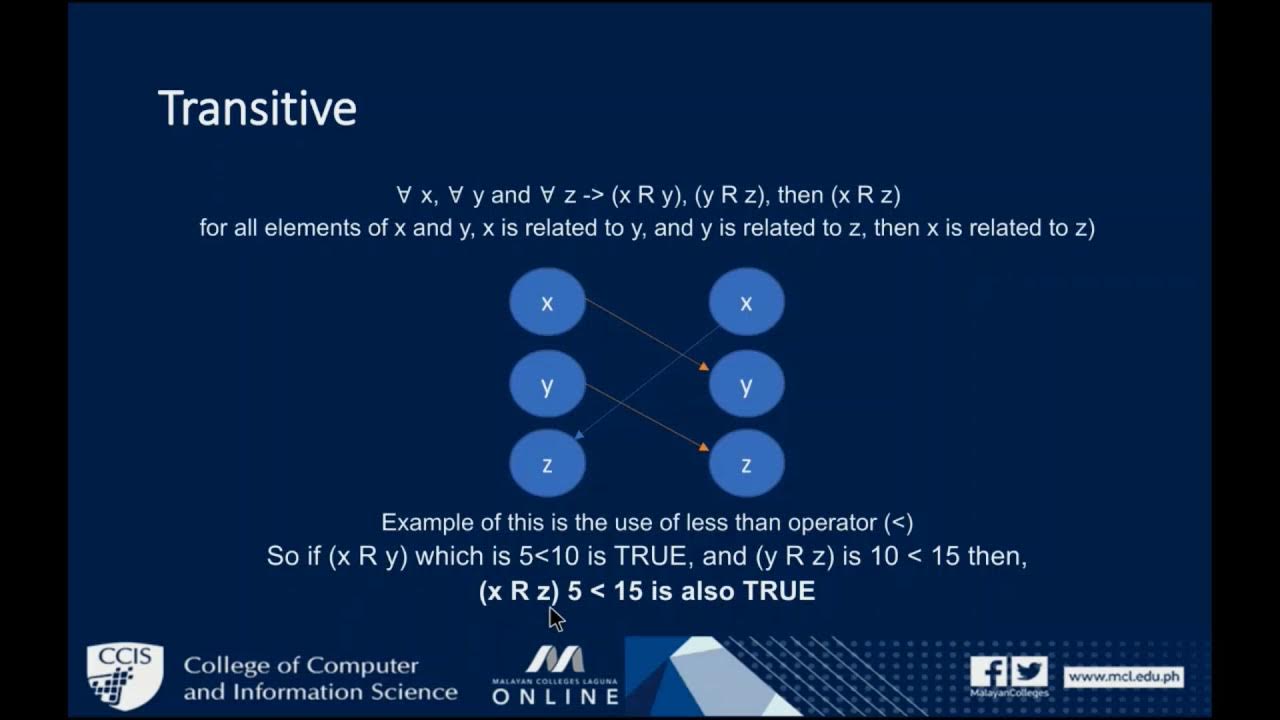Matdis 07: Relasi & Fungsi (Segmen 4: Relasi Inversi, Kombinasi dan Komposisi Relasi)
Summary
TLDRThis video provides a comprehensive explanation of discrete mathematics concepts, focusing on relations, inverse relations, set operations on relations, and relation composition. It introduces key ideas such as the inverse of a relation, using matrices to represent and compute them. The video also explores set operations like intersection, union, and difference on relations, along with practical examples. Lastly, it covers the composition of relations using matrices, illustrating how relations from different sets can be combined. The tutorial effectively uses examples and diagrams to make these concepts more understandable.
Takeaways
- 😀 Inverse relation: If R is a relation from set A to set B, the inverse relation R⁻¹ is from set B to set A. For example, if R is 'A is the father of B', then R⁻¹ is 'B is the child of A'.
- 😀 A relation can be represented using a matrix, where each element shows the relationship between elements of the sets involved.
- 😀 Inverse relations can be obtained by transposing the matrix representing the original relation. The rows of the original matrix become columns in the transposed matrix.
- 😀 Binary operations on sets like intersection, union, and difference are also applicable to relations. Operations on relations from set A to set B result in a relation from A to B.
- 😀 Examples of operations on relations include intersection (R1 ∩ R2), union (R1 ∪ R2), and difference (R1 - R2). These operations can be performed using matrices.
- 😀 The composition of two relations is defined as follows: if R is a relation from A to B, and S is a relation from B to C, the composition R ∘ S is a relation from A to C.
- 😀 When performing the composition of relations, you first apply R and then apply S, creating a new relation between elements of sets A and C.
- 😀 Matrix representation of composition of relations involves multiplying the matrices representing the relations, where the multiplication follows a modified logic: 'AND' replaces multiplication, and 'OR' replaces addition.
- 😀 The use of matrices to represent relations allows for straightforward computation of operations like composition, union, and intersection.
- 😀 The lesson provided several examples showing how operations such as intersection and composition work using matrices to represent the relations, ensuring clarity in how these concepts can be applied.
Q & A
What is the inverse of a relation?
-The inverse of a relation R, denoted by R⁻¹, is the relation that reverses the direction of the original relation. If R is a relation from set A to set B, then R⁻¹ is a relation from set B to set A, defined by the pairs (b, a) where (a, b) is in R.
Can you give an example of an inverse relation?
-For example, if R is the relation stating that 'a is the father of b', the inverse relation R⁻¹ would state that 'b is the child of a'.
How is the inverse of a relation represented in matrix form?
-To find the inverse of a relation in matrix form, we perform a transpose of the original matrix. This means that the rows of the matrix become columns and vice versa, representing the reverse of the relation.
What does the operation of union between two relations mean?
-The union of two relations R1 and R2, denoted R1 ∪ R2, is a relation that includes all pairs that are in either R1 or R2. This operation is equivalent to combining all the pairs from both relations.
What is the intersection of two relations?
-The intersection of two relations R1 and R2, denoted R1 ∩ R2, consists of all pairs that are present in both R1 and R2. In other words, it is the common set of pairs between the two relations.
How do we perform the difference operation on relations?
-The difference of two relations, R1 - R2, includes all pairs that are in R1 but not in R2. It represents the pairs that exist in the first relation but not the second.
What is the composition of two relations?
-The composition of two relations R and S, denoted as S ∘ R, is a relation where a pair (a, c) is included if there exists an intermediate element b such that (a, b) is in R and (b, c) is in S.
How is matrix multiplication used in the composition of relations?
-In the composition of relations represented by matrices, we multiply the matrices corresponding to R and S. However, instead of using regular multiplication and addition, we use logical AND for multiplication and logical OR for addition.
What is the significance of the transpose operation when working with relations?
-The transpose operation in the context of relations is used to reverse the direction of the relation. It allows us to switch the roles of elements in the pair, which is essential when working with the inverse of a relation.
What is an example of using a matrix to represent relations and their operations?
-Consider two relations R1 and R2 between sets A and B. If R1 is represented by a matrix and we want to find the union R1 ∪ R2, we combine the elements of both matrices using logical OR for each corresponding pair of elements. The resulting matrix will represent the union of the two relations.
Outlines

此内容仅限付费用户访问。 请升级后访问。
立即升级Mindmap

此内容仅限付费用户访问。 请升级后访问。
立即升级Keywords

此内容仅限付费用户访问。 请升级后访问。
立即升级Highlights

此内容仅限付费用户访问。 请升级后访问。
立即升级Transcripts

此内容仅限付费用户访问。 请升级后访问。
立即升级浏览更多相关视频

יחסים ופונקציות - 3 - חזקות של יחס

Matdis 06 : Relasi&Fungsi (Segmen 3: sifat-sifat relasi)

13. How to perform Max-Min and Max Product Composition between two fuzzy sets by Mahesh Huddar

Intersection of Equivalence Relations | If R is Equivalence Relation then R^(−𝟏) is also Equivalence

CS101 2 Module 3 Relations and their Properties PART1

Kurikulum Merdeka Matematika Kelas 8 Bab 4 Relasi dan Fungsi
5.0 / 5 (0 votes)
